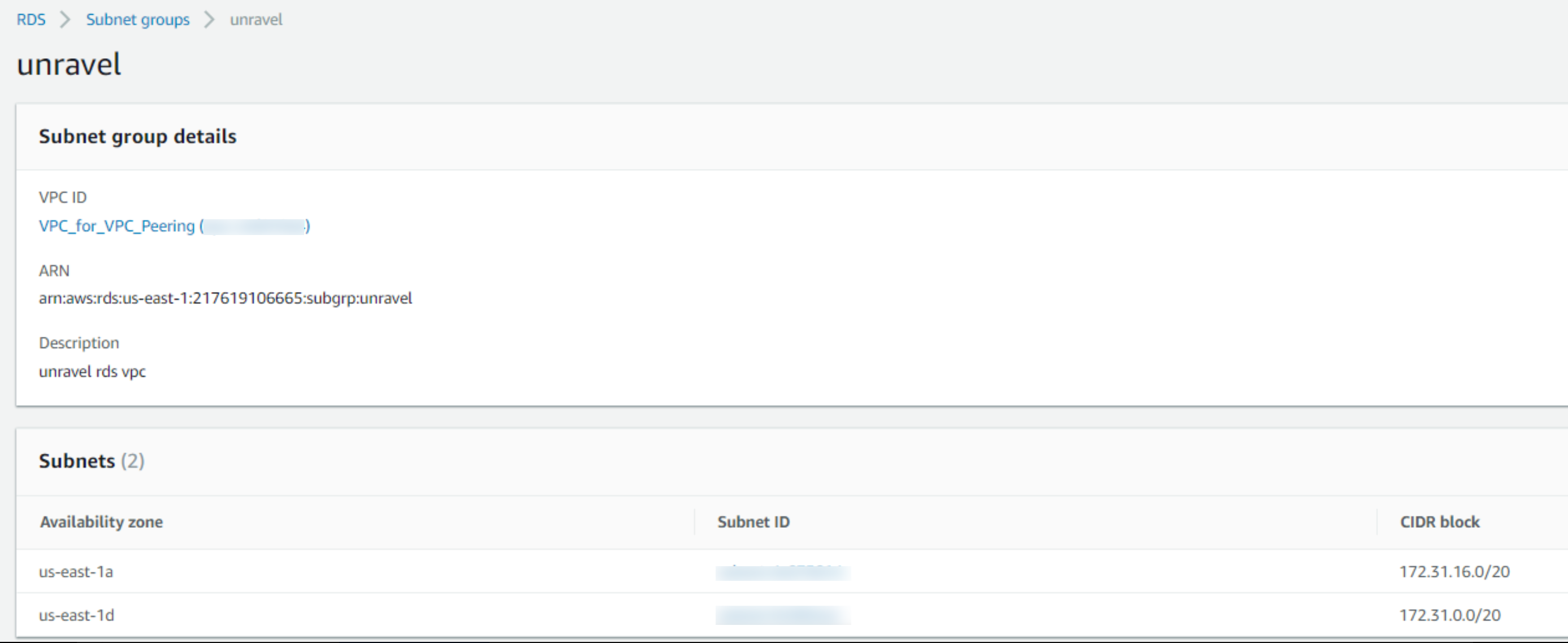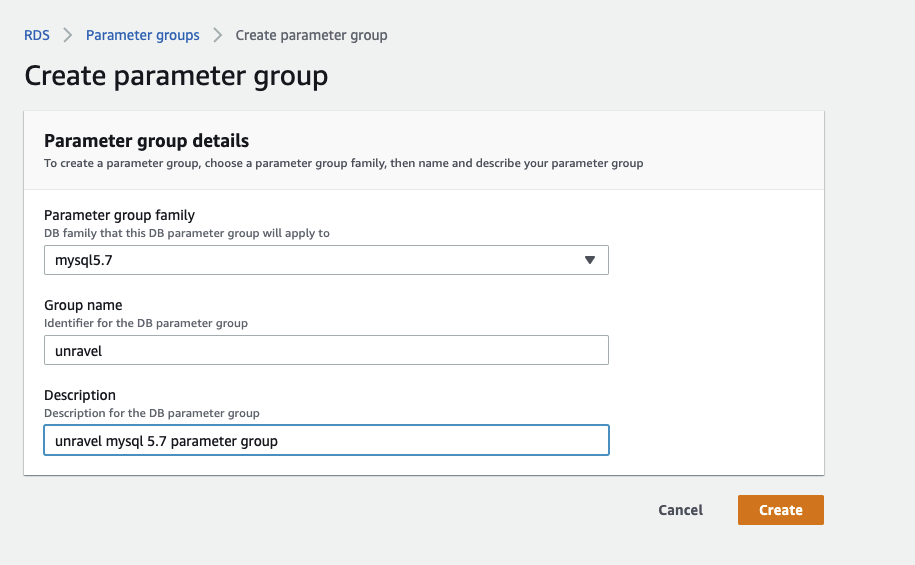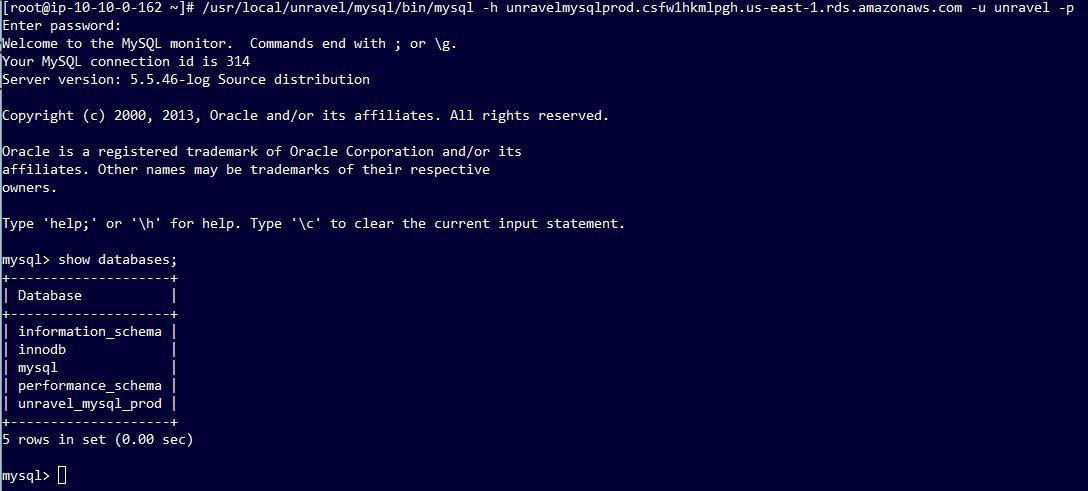Setting up Amazon RDS (optional)
Unravel's default installation uses a bundled database for part of its storage. For better performance and ease of management, we recommend replacing the bundled database with an Amazon RDS instance.
1. Create an RDS security group, subnet group, and parameter group
Create an RDS security group on the VPC of Unravel Server and allow inbound access from Unravel Server security group. For more information refer to Controlling access with security groups
Create a new database subnet group named unravel.
A new database subnet group is required for "multiple availability zone" (multi-AZ) deployment. The VPC should at least contains two subnets in at least two availability zones in a given region, in the same VPC. For more information, see AWS documentation.

Create a new database parameter group with custom settings. Choose a MySQL version compatible with Unravel.

Custom database parameters key_buffer_size = 268435456 max_allowed_packet = 33554432 table_open_cache = 256 read_buffer_size = 262144 read_rnd_buffer_size = 4194304 max_connect_errors=2000000000 net_read_timeout = 300 net_write_timeout = 600 innodb_open_files=9000 character_set_server=utf8 collation_server = utf8_unicode_ci innodb_autoextend_increment=100 innodb_log_file_size = 134217728 innodb_log_buffer_size = 33554432 innodb_flush_log_at_trx_commit = 2 innodb_lock_wait_timeout = 50
Caution
It is not possible to modify a parameter group that is associated with a running RDS instance. To modify a parameter group that is in use, you can do either one of the following actions:
Create a copy of your desired parameter group, make the required modifications, and assign this new parameter group to your RDS instance.
Stop the RDS instance associated with your parameter group, make the change, and start the RDS instance again.
2. Create an Amazon RDS instance
In the Amazon RDS portal, click Create database and enter the following details:
Choose a database creation method: Standard create
In Engine options, select the following options:
Engine options: MySQL
Edition: MySQL Community
Version: MySQL 5.7.33
In Templates, select Production.
In Settings, enter the following information:
DB instance identifier:
unravel-mysql-prodIn Credential Settings, add the following information:
Master username:
unravelMaster password: Change_Password
Auto generate a password: Select the checkbox to auto-generate a password.
In DB instance class, enter the following information:
DB instance class: Select Memory optimized classes (includes r and x classes) and then choose db.r5.large ( 2 vCPU, 16 GiB RAM)
In Storage, enter the following information:
Storage type: Provisioned IOPS (SSD)
Allocated Storage: 100
Provisioned IOPS:3000
Storage autoscaling: Enable storage autoscaling
Select Enable storage autoscaling.
Maximum storage threshold: 1000
In Additional configuration, enter the following information:
Initial database name:
unravel-mysql-prodDB parameter group: unravel-rds
Option group: default:mysql-5-7
In the Advanced Settings page change the following settings.
You can leave all other settings with default values or specify values suitable to your requirements.
Network & Security Settings
Virtual Private Cloud: Select the VPC that contains minimally two subsets and on the same region that you plan to deploy Unravel and the EMR cluster.
Subnet group: Select the new database subnet group you created, named
unravel.Public accessibility: No
Availability zone : No Preference
VPC security group: Select the new VPC security group you created.
Click Create database.
3. Connect Unravel to the RDS instance
By default, the security group created for the unravel RDS has no network access granted on port 3306 on the subnet connected. You must modify the security group applied on Unravel RDS.
In the Amazon RDS dashboard, locate the MySQL database endpoint.
Look for the security group used for the Unravel RDS instance.
Modify the inbound rule of the security group by adding a new rule to allow connections from either:
The Unravel EC2 instance's security group.
The subnet IP block in which the Unravel EC2 instance located.
Either the security group or IP block works, provided the RDS instance is located on the same region as the VPC.
Install MySQL client on the Unravel server and then verify the MySQL connection.
yum install mysql mysql -h
<RDS-Hostname>-u unravel -p mysql> show databaseFor example,

Verify that the database
unravel_mysql_prodhas been created; if not create it.CREATE DATABASE IF NOT EXISTS unravel_mysql_prod;
4. Create a schema for the RDS instance
Stop Unravel
<Unravel installation directory>/unravel/manager stop
Set or add the following properties in the table as follows:
<Unravel installation directory>/unravel/manager config properties set
propertykey##For example: /opt/unravel/manager config properties set unravel.jdbc.username unravel /opt/unravel/manager config properties set unravel.jdbc.password P@sSworD /opt/unravel/manager config properties set unravel.jdbc.url jdbc:mysql://unravelmysqlprod.csfw1hkmlpgh.us-east-1.rds.amazonaws.com:3306/unravel_mysql_prodYou can use a hostname; but to avoid DNS lookups use an IP address.
The database password can be encrypted.
Refresh database.
<Unravel installation directory>/unravel/manager refresh db
Apply the changes
<Unravel installation directory>/unravel/manager config apply
Start Unravel
<Unravel installation directory>/unravel/manager start